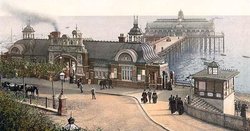- Home
- Replacement Artwork,logos,etc Available
- The Allwin Arcade
- Trade Stimulators
- The Strange & Unusual
- The Aristocrat Collection
- The Bally Collection
- The Bell-Fruit collection
- The BDR/BMR Collection
- The Bryans Collection
- The Buckley collection
- Caille Brothers Collection
- Working Models
- The Groetchen collection
- The Hawtin's Collection
- The Jamieson's Collection
- The Jennings collection
- The Mills Collection
- The NSM (Bingen) Collection
- The Oliver Whales Collection
- The Pace Collection
- The Parkers Collection
- The Rock-ola collection(slot machines)
- The Ruffler & Walker Collection
- The SEGA Collection
- the Shefras collection
- The TH.Bergmann Collection
- The Tom Boland collection
- The Watling collection
- The Whittaker Bros Collection
- the Wondermatics collection
- The Wulff Collection
- The Juke Box Age
- Coin Operated Cranes & Diggers
- Coin Operated Shooting Games
- Coin Operated Weight Scales
- slot machine coins & tokens for sale
- Amusement Arcades from the Past
- The British Seaside Pleasure Pier
- The Market Place
- Coin Operated Related Seaside Postcards
- See a Selection of the More Complex Machines at Work
- Stuart Dale's Imperator Rebuild
- Stuart Dale's Steam Shovel Project
- The "Allwin" Machine
- Useful Links
- The Rye Heritage Ctr Collection of Working Models
- Williamson's Vintage amusement arcades
- Contact Us
.
The British Seaside Pleasure Pier
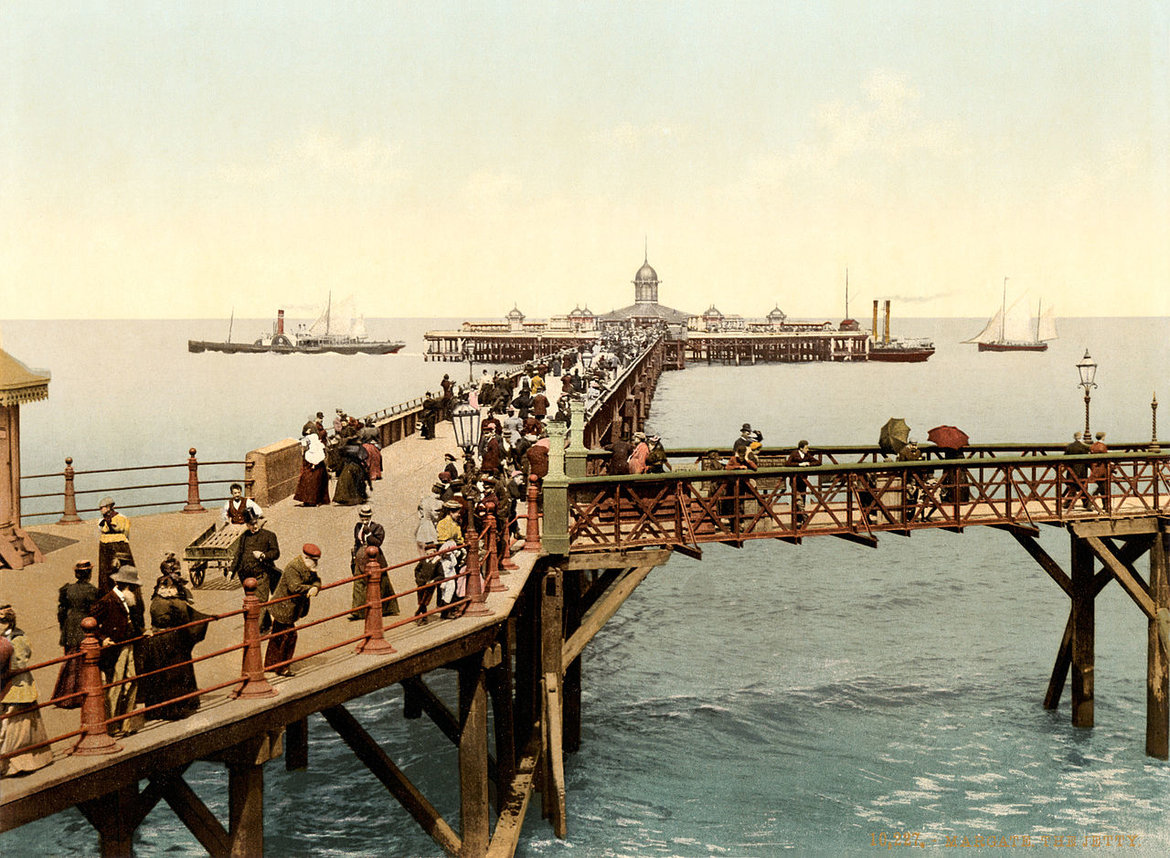
Margate Pier 1897 (note the passenger Steamers using the pier
To coincide with the publishing of a great new book looking at seaside piers seen through postcards (The British Pier, The Postcard collection, Nigel Sadler, available in our market place at a very special price) we have decided to launch a page on the British pleasure pier seeing as the seaside pier and the coin operated amusement machine are so closely linked. This will be different from our normal format and will be a constant work in progress relying on photos and postcards submitted by our readers to be added as time goes by.

Please send your Pier Photos(past and present) through the link below or the contact page
all photos will be credited to the sender
There are some excellent and comprehensive sites on the web dealing with the sea side pier and we will leave the detailed history of the pier to them . Here we will confine ourselves to a short background of the seaside pleasure pier and a pictorial library of as many piers as possible.
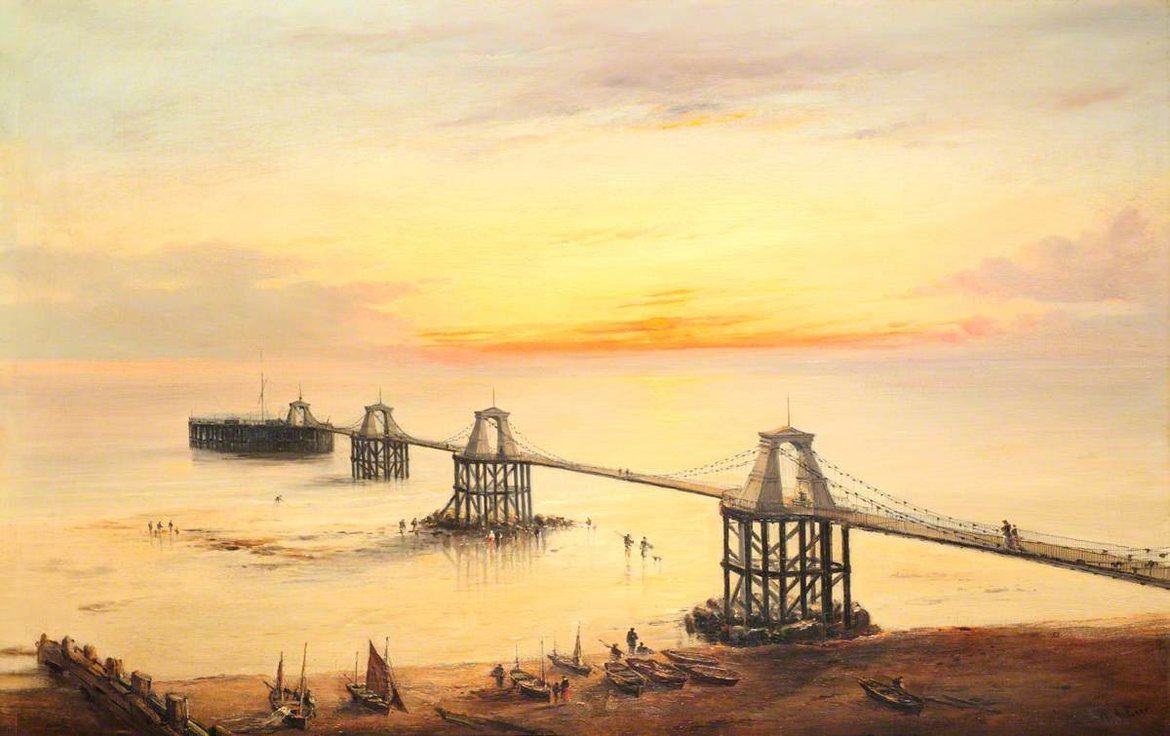
Brighton Chain link Pier 1830's
Firstly what qualifies as a sea side pleasure pier and why were they built? At first it would seem to be obvious why they were built, on an island that is surrounded by tidal waters and in an age when the coastal passenger steamer was an important means of transport a docking pier would be essential and, indeed the very first pier (Ryde, Isle of Wight 1814) was exactly this. In the 1950's most piers still retained their landing stages although by that time they were mostly the haven of the rod and line fisherman. Most have now lost the landing stage.
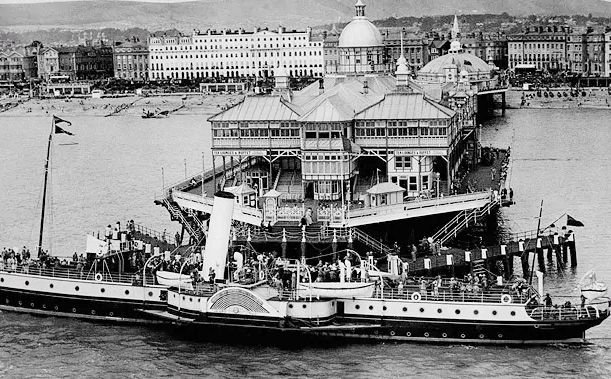
Eastbourne 1930's these paddle steamers ran trips along the coast and to France
Its generally accepted that this was the main reason the early piers were built in the first place but not the only reason ,especially the later ones . The sudden popularity of the seaside town was ,for the most part, due to cheap rail travel which would also be the main reason for the decline of the coastal passenger steamer and it wasn't long before the steamers were a function of the pier rather than ,as it was originally, the other way round as the steamers became more of pleasure ride than a means of transport from one place to another.
Many piers were built predominantly as a pleasure pier, The pleasure pier was, and still is, a strange phenomenon, most people outside the Uk cant understand it, the ability to walk out over the water has always given an odd and exciting feeling ,different from a boat ride. For me as a small child it was always the pier that was the big draw at a seaside town, seeing the water through the slatted floor and rushing to the furthest point were the water was deepest (not to mention the amusement arcade of course) These days you might expect the modern child to have no interest in this simple thrill but not so, its always been my experience that a small child taken onto a pier will immediately forget the phone in one hand and the game console in the other and be enthralled by the very nature of the pier. There were always arcades, rides, candy floss and booths on the land but they were never as interesting as those on the pier.
For adults perhaps the charm has disappeared along with the end of the pier theatre, the palm dining room and the Sea view bar but those childhood memories still have a soft spot in our hearts.
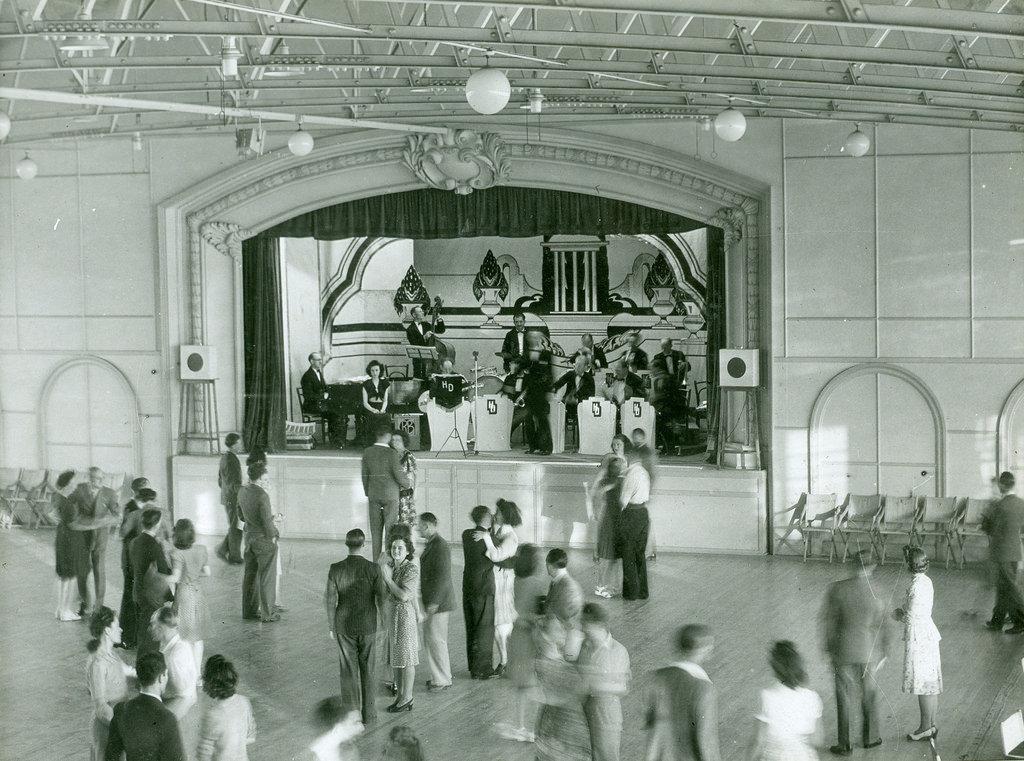
The Pier Ballroom Hastings late 1940's
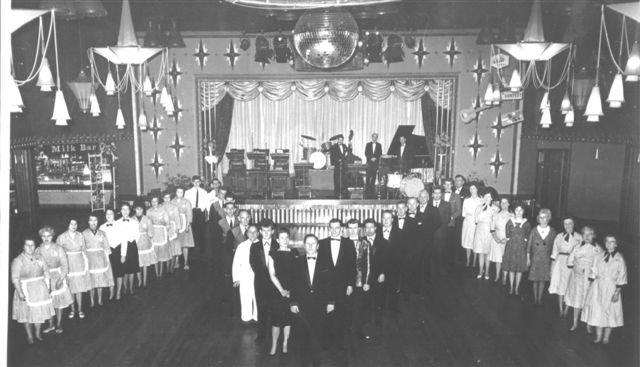
The large number of staff needed at the Royal Pier Ballroom Southampton
Although many piers pre date, and some post date the Victorian era ask anyone in what style the pier built and they will say Victorian, even if its blatantly deco, its just something piers are.
Over 100 were built and around 60 still remain. buildings come and go and people are often glad to see them go, but loose a pier and everyone is sad. Perhaps its those childhood memories, whatever it is piers are deep rooted in the British public.
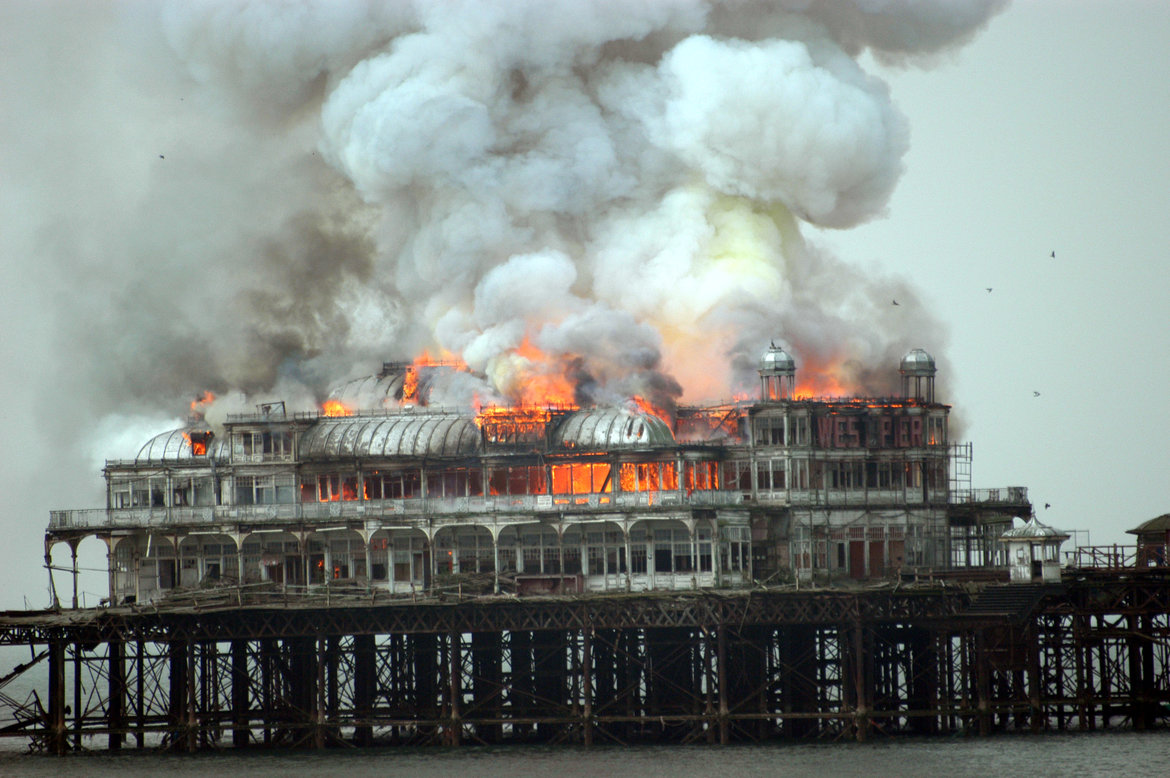
The loss of one of Britain's most iconic piers, West Pier,Brighton March 2003
The British Seaside Piers
Western-Super-Mare
. 
Bimbeck (or "the old pier") built 1867, 351 mts long, Grade II listed currently derelict
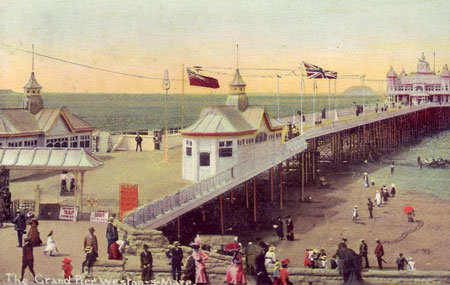
The Grand (or new Pier) built 1903, 351 mts long ,Grade II listed
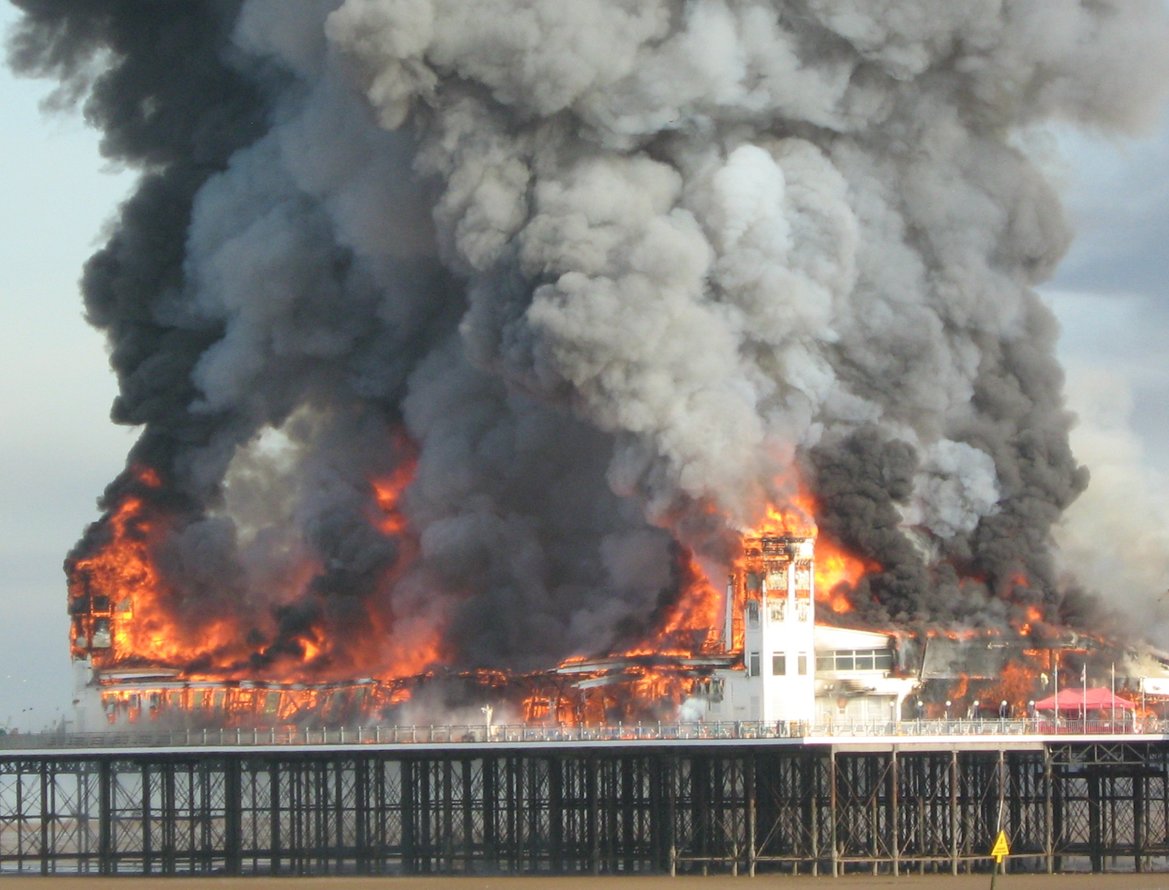
Destroyed by fire in 2008 shortly after being refurbished
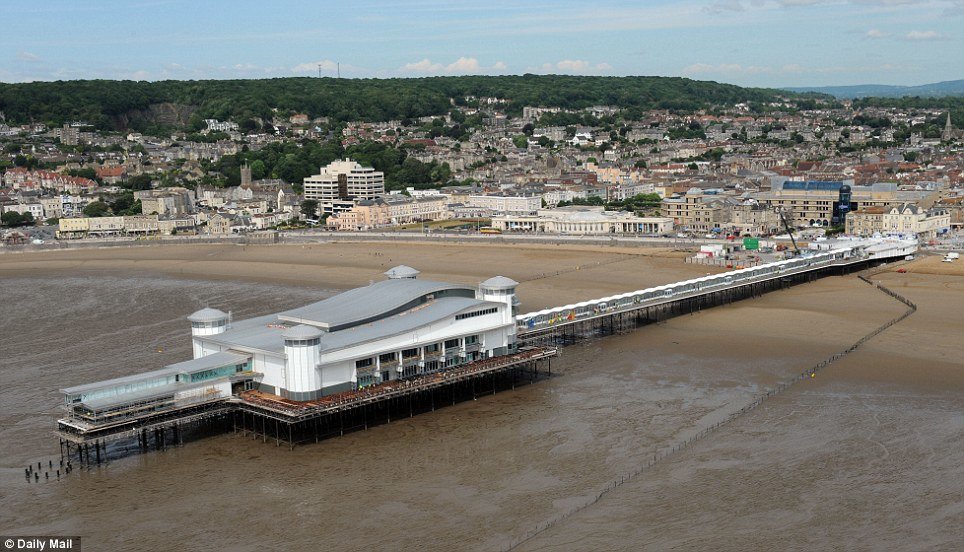
Today's pier, re-built at a cost of £39 million, opened 2010, 400 mts long
Western-Super Mare is a good example of how the British feel about their piers, The town just refuses to part with theirs. The original Bimbeck pier is still there,derelict but still with hope of being saved , The later Grand pier,damaged by fire in 1930 and destroyed by fire in 2008 was re built in lavish style in 2010
Hastings Pier
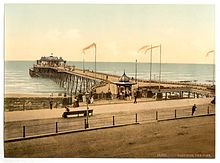
Early photo(original Pavilion)
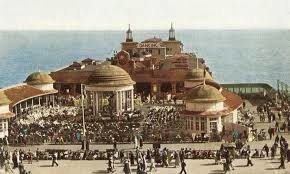
The pier (built 1872, 280 mts long)in its hayday with bandstand and new pavilion
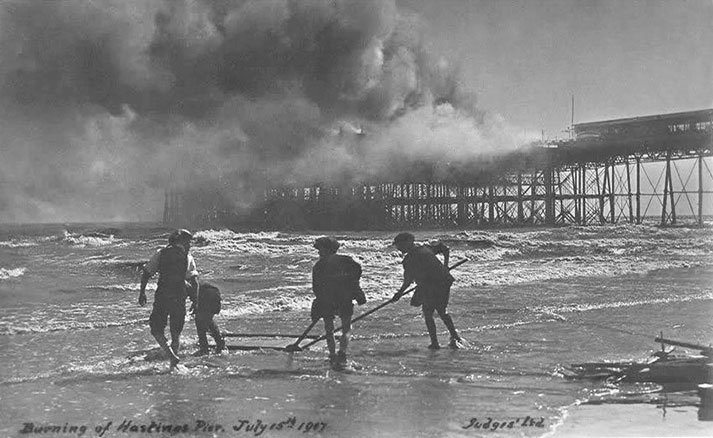
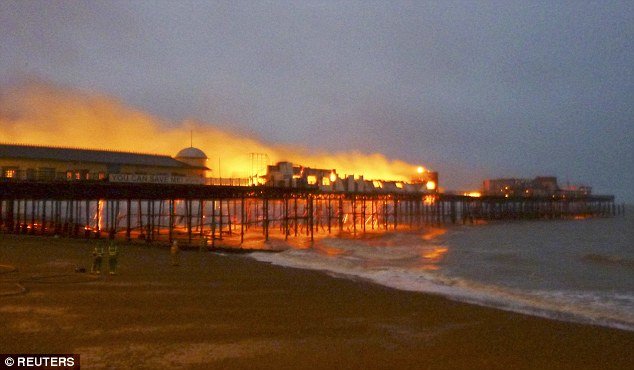
the 1947 fire the 2010 fire
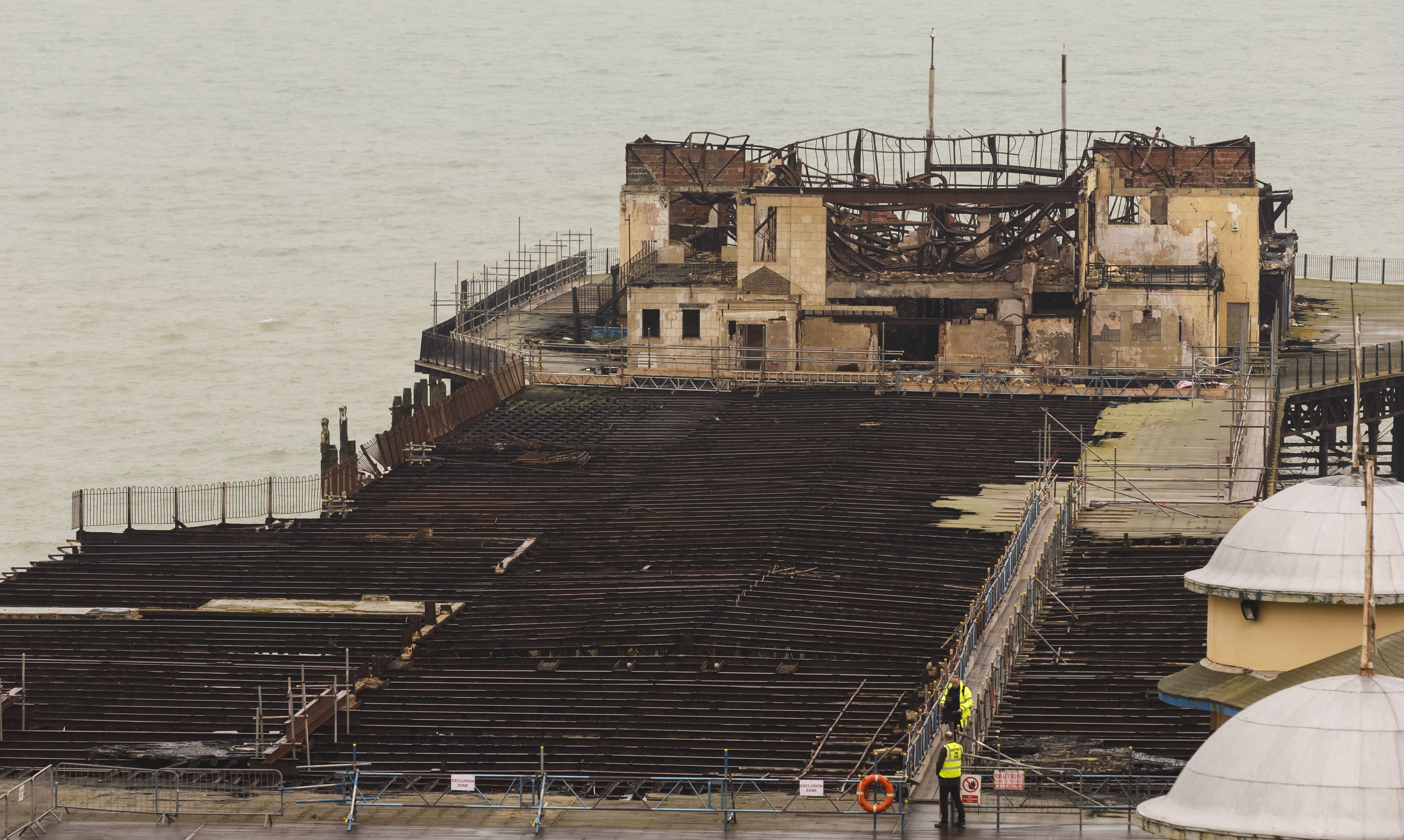
the aftermath of the 2010 fire
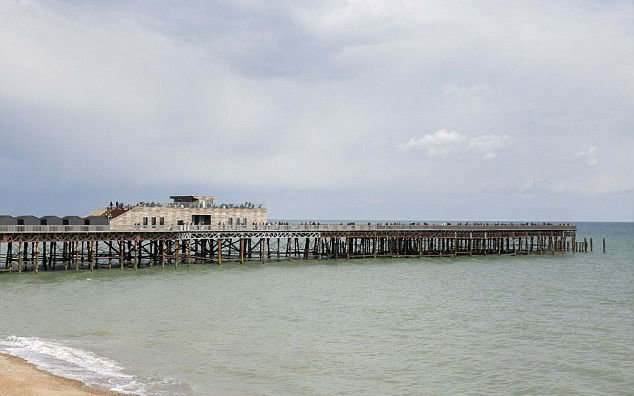
The new pier 2016
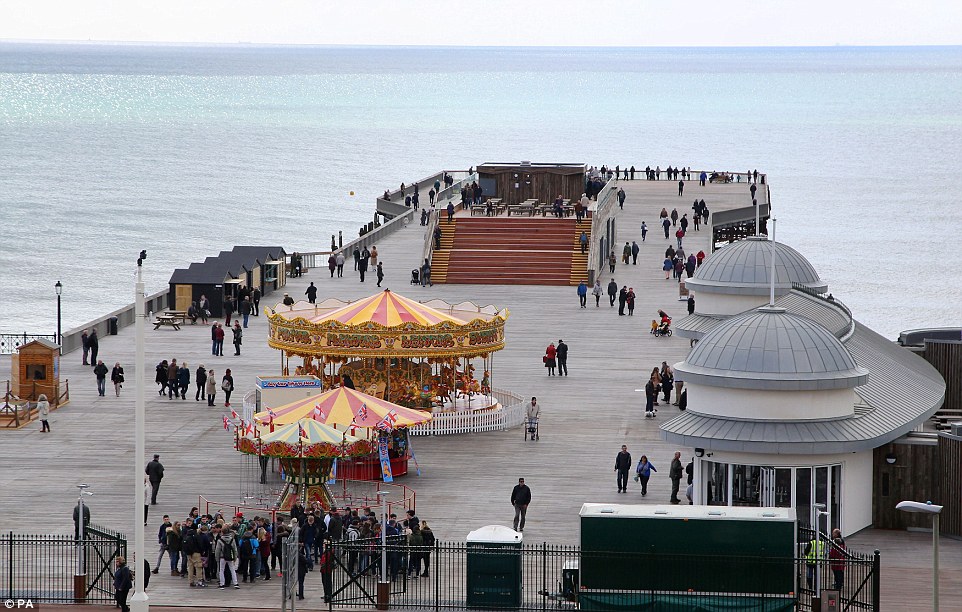
The first Hastings pier was designed by Eugenius Birch and built in 1872, at its height it was one of the most popular piers in the south boasting a huge bandstand and large pavilion hosting the top acts of the day . As with so many piers fire has played a big part in its history,the original pavilion was destroyed by fire in 1917 and pretty much the whole pier was lost in 1947 but it was in 1990 that the old piers fate was sealed , no t by fire but by storm damage. Lack of investment by various owners to correct the damage led to the pier being closed to the public in 1999,poor work led to another partial closure in 2002 and total closure in 2006. An unwanted (by the owners) grade listing on the building and lack of funds left the pier derelict until it was totally destroyed by fire in 2008 . As usual with the British public's love of seaside piers the demands to re build were loud and the local council enforced a compulsory purchase order securing ownership of the pier for the town. Surprisingly a structural survey found the base structure to be sound and a new,very modern style pier was planned,built, and opened in 2016. The new,very plain style,utilising the original pier's unusual width is not to every ones liking(including me) but the National Piers society thought it good enough to be awarded "pier of the year" in 2017
The Trinity Chain Pier,Edinburgh
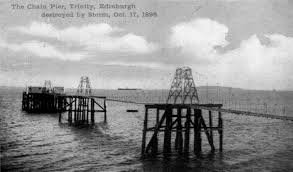
This pier must get a mention, firstly it a very early pier and second it defiantly had a pleasure pier affiliation.The pier was built by Captain Samuel Brown and opened in 1821. Brown was an interesting man, a Royal Navy captain he spent much of his time in the navy developing chains to replace ropes on navy ships anchors. After he left the navy he opened a chain factory and gained several patents. He first built two suspension bridges in Scotland, both collapsed, one was rebuilt...and collapsed again. A later bridge over the Tweed was more of a success and is still in use today. The Trinity chain pier was built to serve steamers bound for Granton harbour, it was 650 feet long but only four feet wide. It was initially very successful but by the 1850's the new harbour was taking most of the trade. At this point it became a pleasure pier being used as an access point to the water for swimmers. So popular was this that trains would bring swimmers from far and wide to use the pier. The pier collapsed in 1898 (two years after Brown's other chain pier at Brighton did the same) due a combination of poor maintenance and a huge storm.
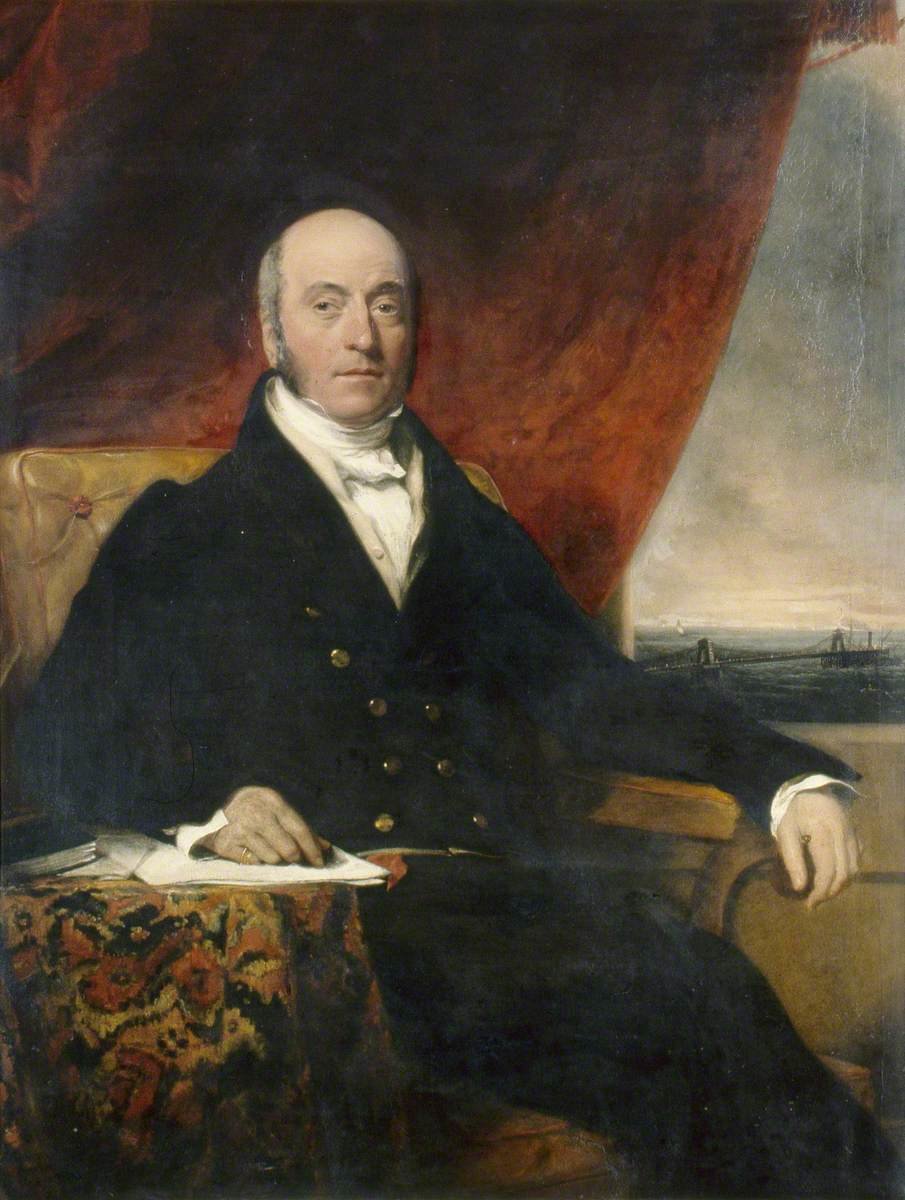
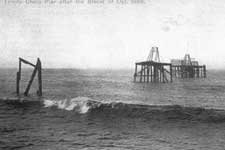
Cpt Samuel Brown The end of Trinity Chain pier 1898
Brighton West Sussex
With Brighton being one of the two most famous seaside resorts in the UK in not surprising that it has had three piers,indeed all three existed at the same time for a short period.
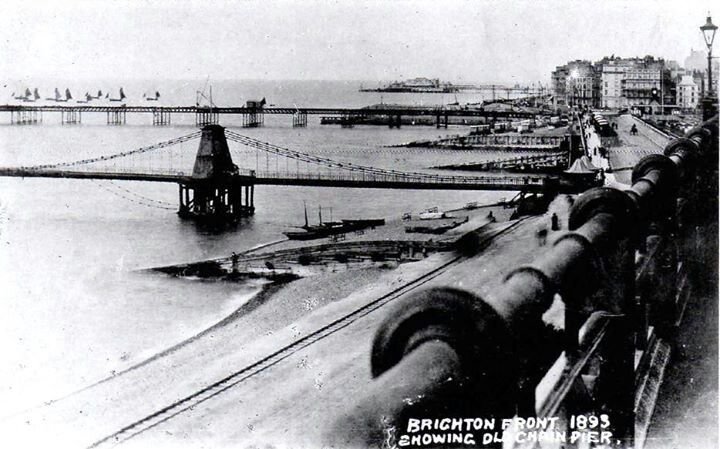
The chain pier with the Palace pier and thr West pier in the distance
The Royal Suspention chain pier was the first, designed and built by Captain Samual Brown RN in 1823 as a landing stage for packet boats to France it did have several attractions on it including a camera obscurer . It held out till 1893 when part of the agreement to build the Palace pier was that the chain pier would be dismantaled. In the end nature saved them the trouble when the chain pier,already derelict and closed was distroyed in a huge storm on Dec 5th 1896. The huge waves rushing between the towers coupled with the high winds caused the towers to flex in turn causing the roadway to twist and swing eventually pulling over the towers.Not all of the pier has gone however, the two entry booths were moved to the palace pier where thay exist today as small shops, the piers signal cannon is also now on the palace pier. During very low tides the oak piles and stone blocks of the towers can still be seen in their original positions.
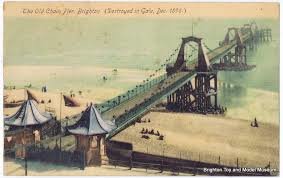
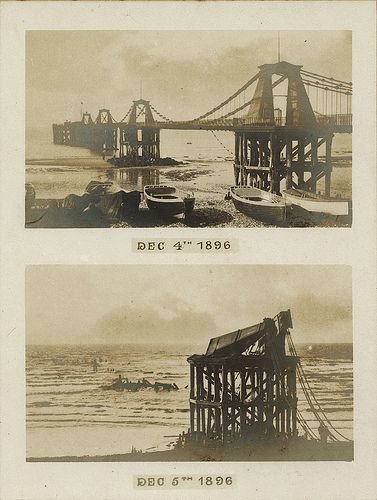
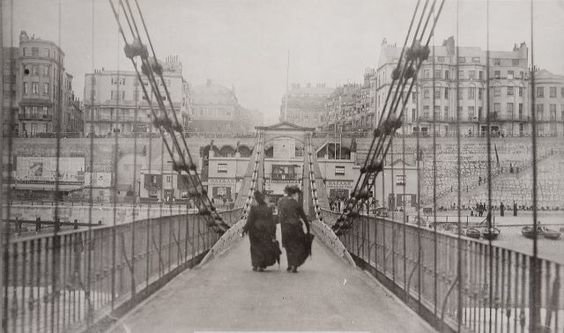
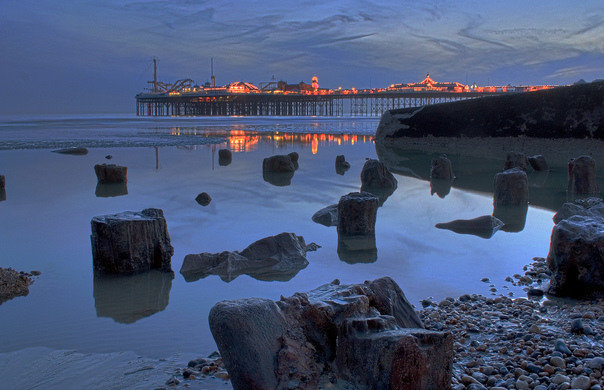
taking the air on the chain pier 1850 the original oak piles look out towards the Palace pier
The Palace Pier
The Brighton Palace pier was one of the last UK pleasure piers to be built during the hayday of pier building(1893), one of the most successful and, for the most part, one of the luckiest. The pier was built with a small concert hall at the far end but little else but its instant success meant improvements and additions game quickly and within a few years the concert hall was converted into a theatre . When the pier's jetty was no longer needed this was not removed but used to extend the pier even more to huge structure it is today. The pier cost a record £27,000 to build and is now 1719 feet long (524 mts).The pier has,for the most part, been lucky enough to avoid that terror of the seaside pier, fire a large fire was contained in one area in 2003 and disaster was avoided. But it did suffer severe damaged in 1973 when a barge that had broken free crashed into the pier causing part of it to collapse into the sea. The theatre was never used after this and was removed some years later on the understanding it would be replaced, it never was. New owners changed the name to "The Brighton Pier" but ,as usual with seaside piers, the public sprang to its defence and after years of campaigning the pier was renamed "The Brighton Palace Pier" in 2016.
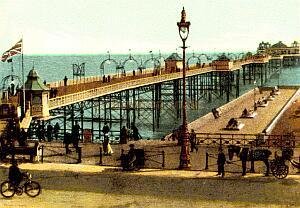
Palace Pier 1900
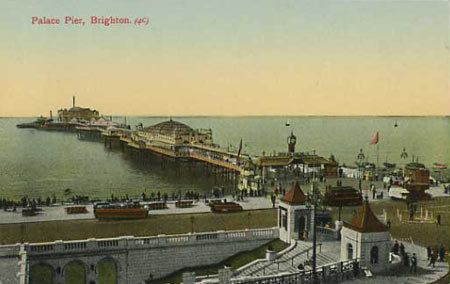
1930's

2017
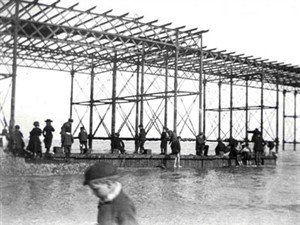
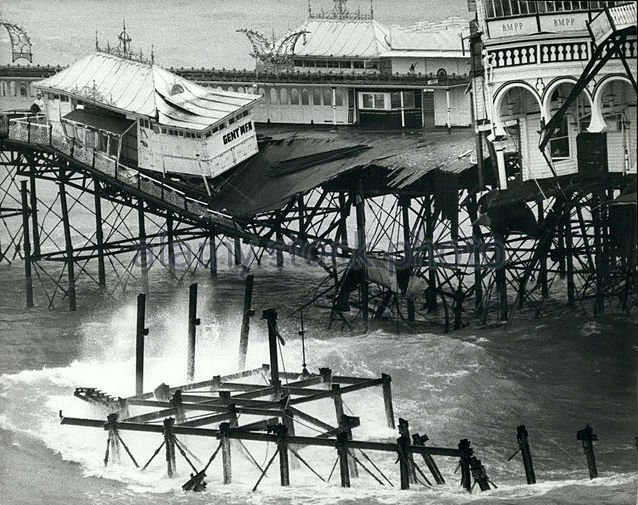
construction 1898 damage caused by barge 1973
Boscombe Pier ,Dorset
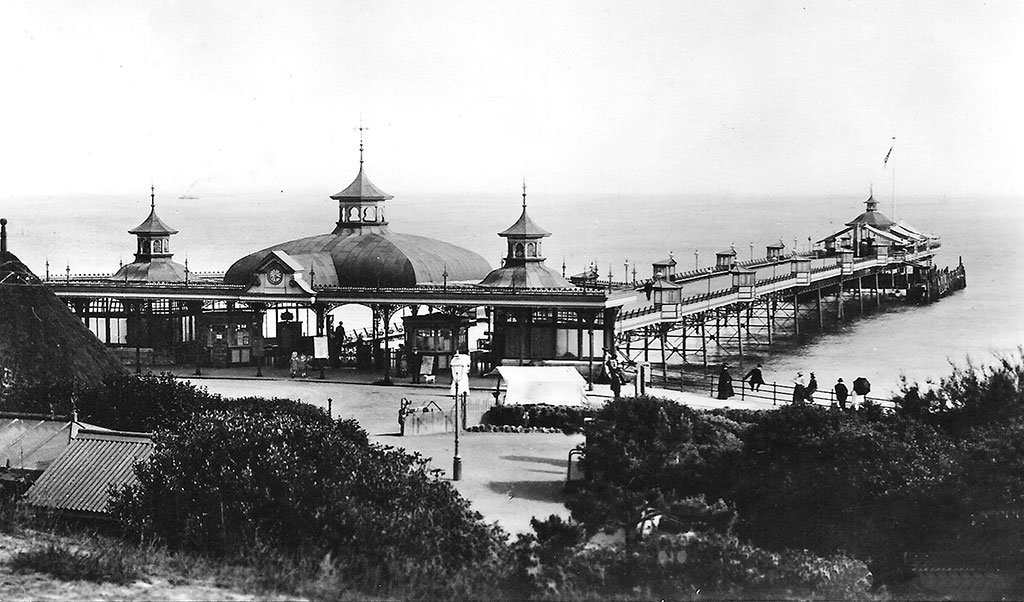
Boscombe Pier around 1900 (600ft)
History wise Boscombe Pier is a bit of an enigma , fact is it was never a success during it first 100 years and even today its future is dubious. Opened in 1889 it was always going to play second string to its big brother in nearby Bournmouth. Access to the beaches at Boscombe has always been difficult with high cliffs directly behind the pier and a cliff railway was needed to improve things . The pier struggled along and the pier head was re built in concrete in the 1920's. Along with most piers the pier was breached during the war to prevent it being used in an invasion and was slow to be re built (I remember it still cut in the 1950's). The head was again re built in concrete in 1960 and a restaurant and the Mermaid Theatre added. Still the people didnt come and the theatre was,I believe, never used as a theatre opening as a roller skating ring for the first two years before being converted to an amusement arcade in 1965. In 1982 the pier head closed as unsafe and was removed and replaced with a fishing and viewing platform in 2008. In 2011 the Boscombe land train route extended as far as the pier and it found a popularity it had never seen before,. About this time cracks started to appear in the new pier head causing some concern, at the same time the new lighting was turned of as unsafe as it shorted out during rain. By 2015 all the concrete piles on the pier head were showing cracks.This rather unlucky pier now contains no structures and looks very much like a landing stage to nowhere. Its future remains uncertain
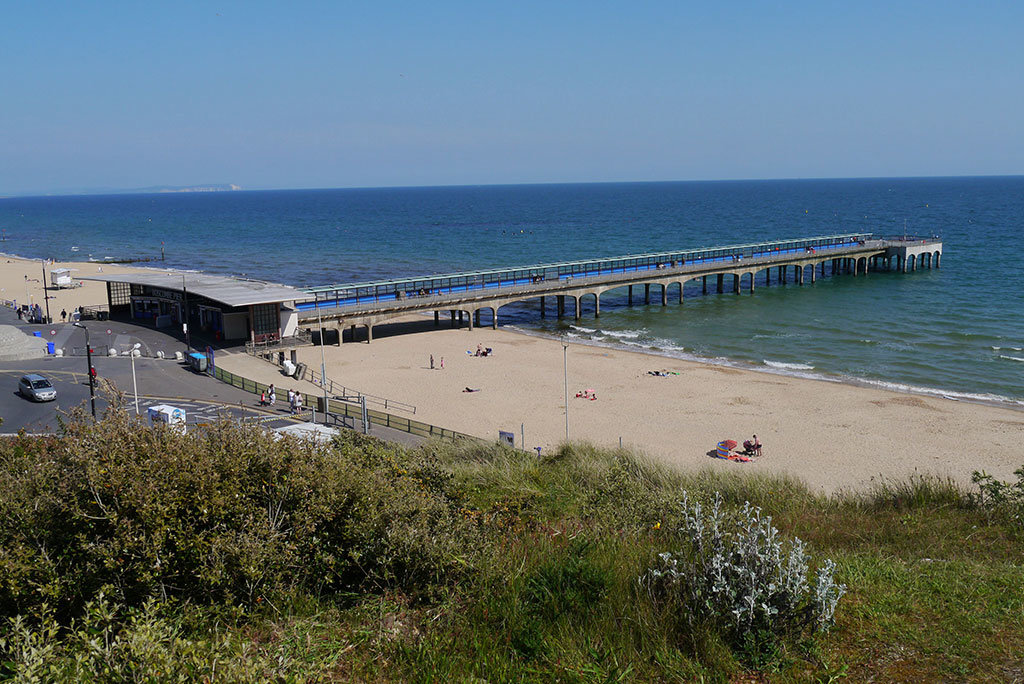
Boscombe Pier 2017 (700ft)
Hearn Bay ,Kent
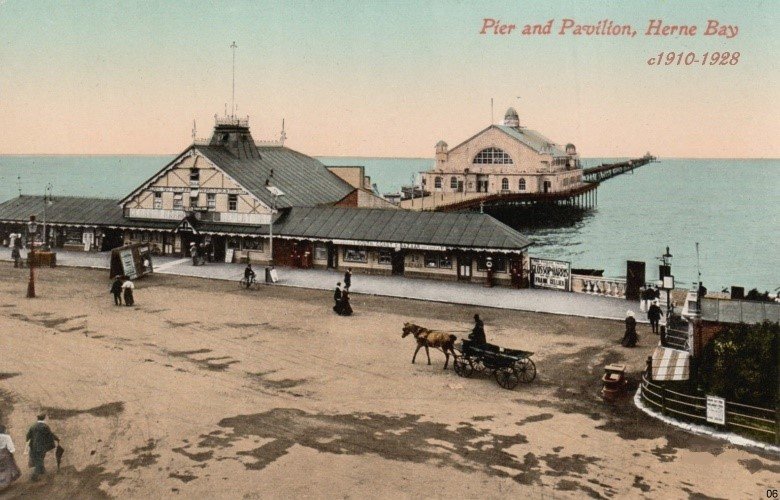
The third pier complete with 1910 pavilion
The history of Hearn Bay pier is a very interesting one, full of rear facts and interesting outcomes. In 1800 the population of Hearn Bay was 12 but the opening of a military camp and the rise of the seaside resort saw its numbers rocket by 1835. With no railway the only way to get large numbers of people to the town was by steamer and the first pier was built to do just that. Finished in 1832 it was a staggering 3,613 feet long, due to the shallow sea in the area it had to be that long to allow the steamers in. This first pier had other interesting points. The ancient London bridge(the one with the shops and houses on, 1250-1831) had just been demolished and the balustrade form the bridge was bought by the pier company and used on the pier, the pier also boasted a sail driven luggage train, although this was manually pushed on still days.
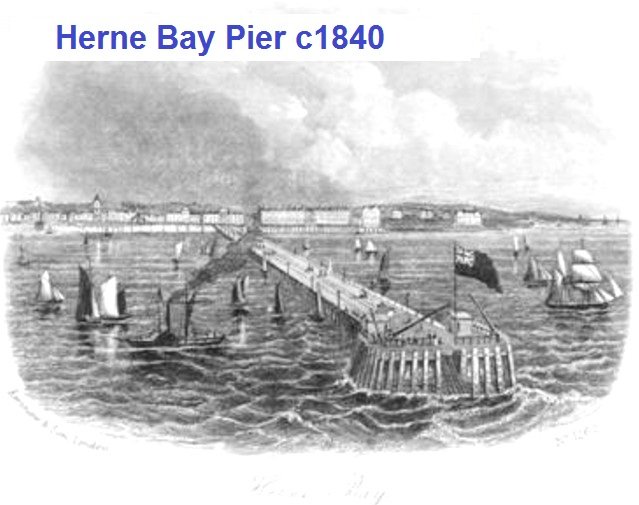
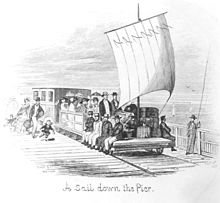
the first pier the sail train
The pier was built using un protected wood piles and by 1850 ship worm was rotting the pier away, the arrival of the railway in 1860 spelt the end of the pier as a landing stage and, disused and derelict it was dismantled in 1870.
The new pier company bought the area and built the second pier in 1871 in only 4 months. The historic balustrade from London bridge was again used but the pier was a mere 328 ft long with all its amenities at the land end. A theatre was added by a third party in 1884
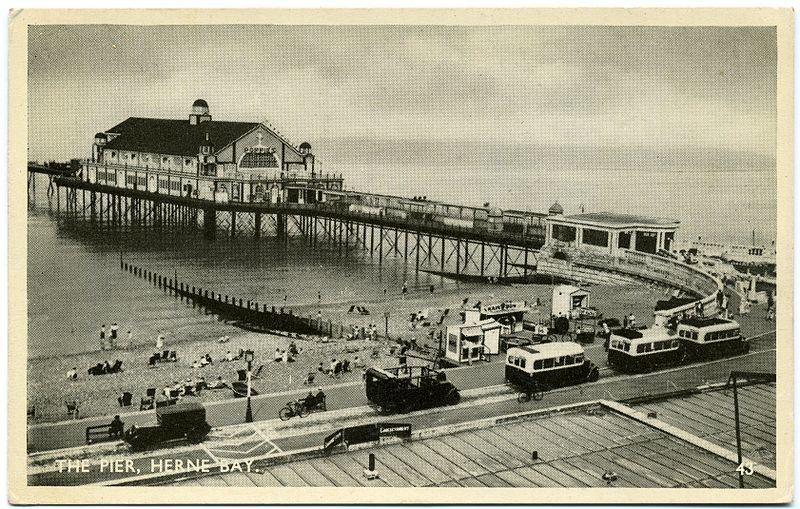
Although a later photo this is what the 2nd pier looked like in length prior to 1899
By 1899 the steamer was back in fashion only this time as a pleasure boat and a deep water pier was needed, permission was sort to lengthen the pier and by 1910 this was finished the length now a massive 3787 feet making it the second longest in the UK. A majestic marble floored pavilion that could hold 1000 people was also built at this time .
An Electric tram was added in 1924 and the pier experienced its hay day between 1920 and 1939
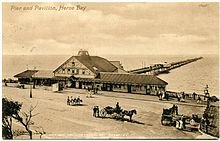
The third pier prior to the addition of the 1910 pavilion
The pier was well made and survived a massive storm untouched that destroyed the seashore and promenade in 1919.
WW2 marks a big change in the piers life, handed over to the army and covered with camouflage and barbed wire the mid section was eventually blown up by the army in 1940 during the fears of invasion. After the war bailey bridges were used to bridge the gaps but structural damage had been cause to the remaining area that was to cause problems for years to come. The electric tram was sold for £12 in 1950 as it could not cross the bailey bridges and a narrow gauge steam railway was installed. In 1953 the old London bridge balustrade was removed and this incredible peace of history was lost. In 1963 nature took a hand when the sea froze up to a mile out, the tides continued to rush in and out under ice and this and the rapid thaw that followed caused considerable damage to the piles. Plans to refurbish were put forward at several intervals over the next few years but Huge storms in 1978/79 caused much of the pier between the two bailey bridges to collapse and the pier was dismantled. The pier head with its pavilion was too solid to remove and stands today in majestic isolation in the distance. The now short stubby pier had a new pavilion built (known as the "cowshed" to locals) this was demolished in 2012 .
Today the pier has tried something new, The space where the cowshed stood is now taken up with beach huts (or should I say pier huts) and some amusements, a unique and slightly odd idea.
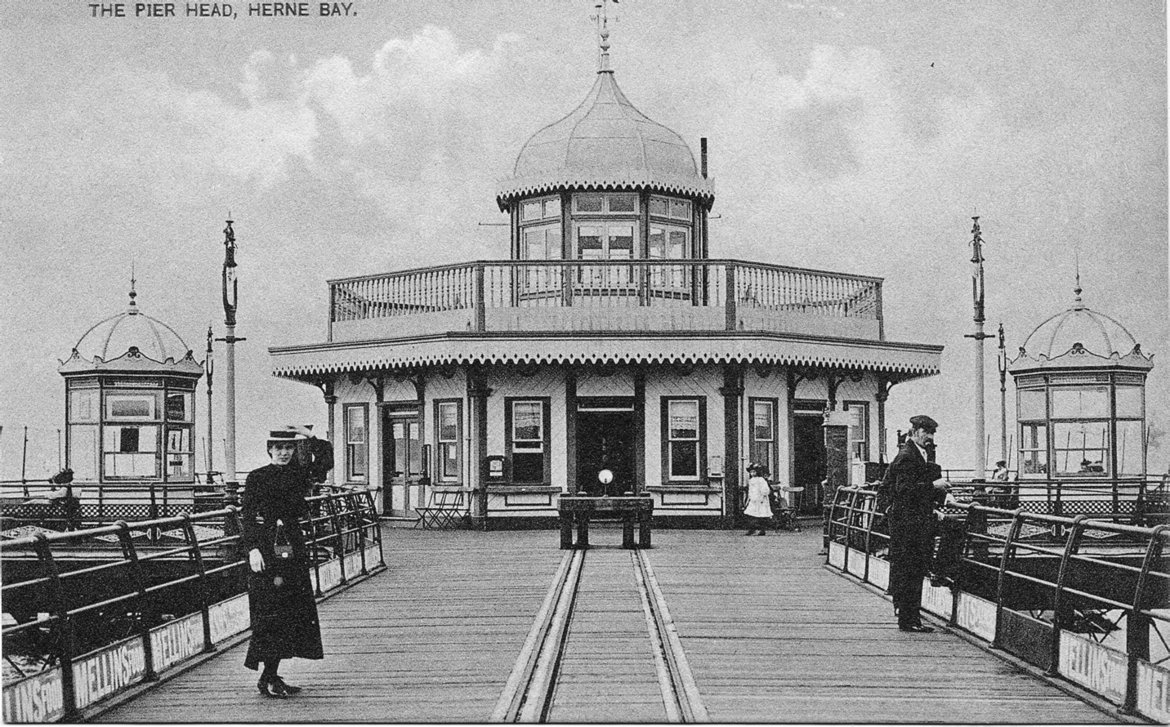
The pier head at its height
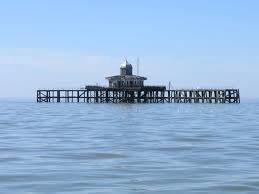
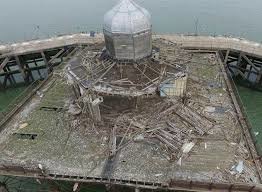
The pier head today
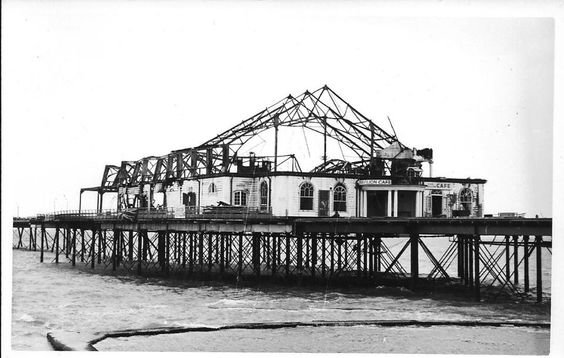
Like most piers Hearn Bay has had its share of fire damage
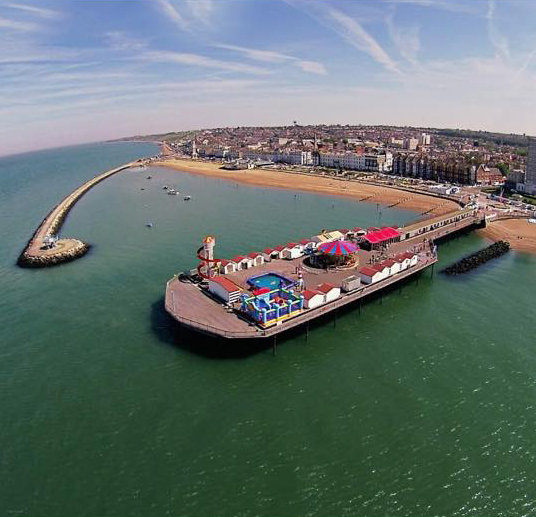
The pier today with is "pier Huts"
----------------------------------------------------------------------------------------------------------------------------------------------
-----------------------------------------------------------------------------------------------------------------------
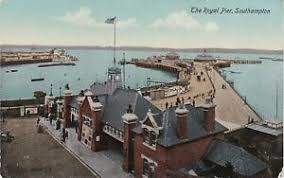
The pier in its early form
Southampton Royal Pier
The Royal pier Southampton must have seemed a gold mine when it opened in 1833,The town was then ,as it still is today, a major international passenger port and the pier owners must have envisaged huge profits. The 900 ft structure was important enough to warrant being opened by not one but two royals, The duchess of Kent and the then Princess Victoria (later to become queen) so its royal name was well deserved. The odd shape of the pier leans more towards the shipping angle than a pleasure pier but it was always envisaged as a sea side pier in the traditional sense.
Within 5 years design faults (the use of wooden piles) was causing major problems and major restoration was needed but still the pier had great potential. A large pontoon was added in 1864 and railway lines were laid right to the pier head in 1871 complete with a pier head railway station. These were the days of the "boat Train" with transition from train to ship made as easy as possible.
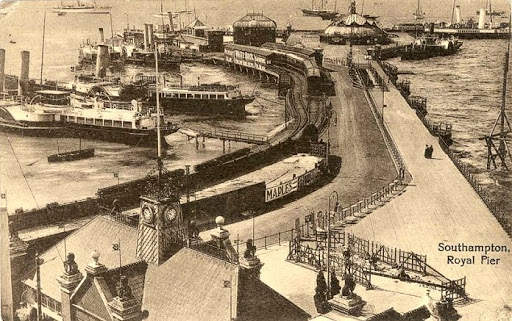
Railway tracks leading to the pier head railway station in 1910
The pontoon was enlarged in 1892 and a pavilion added in 1906,. Restaurants, dances and rollerskating were now a regular feature and the pier was,perhaps at its height.
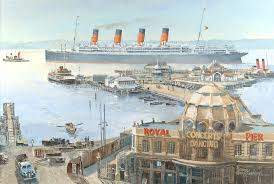
The Cunard steamship Aquatainia passes the pier around 1938,the pier covered a substantial area at this time
From this point on the pier's fortunes were all downhill,even before WW1 the railway station was in poor repair and the wooden piles were again rotting away. Trains were stopped from using the pier during the great war and in 1921 it was decided not to reinstate them although the red funnel ferries still used the pier.
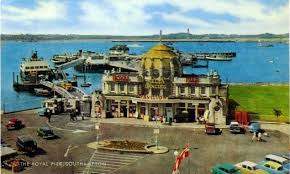
The new 1937 Gatehouse
An impressive new land side gate house was built in 1937 just in time to witness bomb damage to the pier during WW2. The pavilion and gate house were reopened in 1947 and the pier had a short revival, a road access was added to the pier head in 1950. Like many other piers The royal spent the next 34 years slowly rusting (or in this case rotting) away, strapped for cash to pay for repairs.
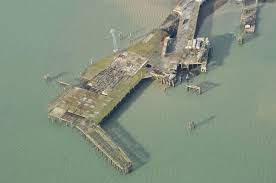
The unusual shape of the pier can be seen in this modern photo of the derelict pier
In 1984 the pier was declared economically unviable and the pier closed in January of that year.The 1937 gate house was in good repair and was bought and restored as a bar/restaurant but just three years later a major fire destroyed the ballroom ,several other fires followed on the pier and by 1997 the owners described the structure as unrecognisable as a sea side pier . Only the gate house was restored to its former grandeur and is now a first rate Thai restaurant that still recognises its debt to the former pier.
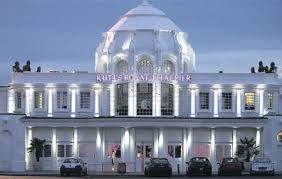
The 1937 gatehouse as it is today, beautifully restored and in use as a Thai Restaurant
In 2014 a £450 million redevelopment plan calling for the demolition of the pier to make way for a huge leisure area was agreed by the council, in 2016 this was revised to include the pier and bring the red funnel ferries back to the area and a reprieve for the pier looked possible,but in 2019 the council pulled out of the whole idea and the plan collapsed leaving the old pier still aging away. A new plan in 2020 to build a casino on the old pier was introduced and is still a possibility
